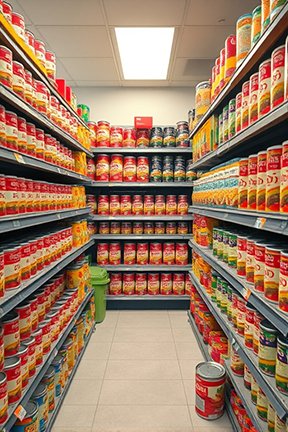Published: February 11, 2016 | Updated: September 23, 2025
Published: February 11, 2016 | Updated: September 23, 2025
The Enduring Legacy of Canned Food and the Power of CMMS
 This time, let's explore the enduring legacy of canned food and the power of a computerized maintenance management system (CMMS). While a CMMS stretches back only about four decades, the humble can of food holds a surprisingly significant place in history and continues to shape how we access and consume nourishment. From its initial purpose of feeding armies to its current ubiquity in our pantries, canned food boasts a compelling story. February, designated as Canned Food Month, serves as a reminder of this innovation's lasting impact.
This time, let's explore the enduring legacy of canned food and the power of a computerized maintenance management system (CMMS). While a CMMS stretches back only about four decades, the humble can of food holds a surprisingly significant place in history and continues to shape how we access and consume nourishment. From its initial purpose of feeding armies to its current ubiquity in our pantries, canned food boasts a compelling story. February, designated as Canned Food Month, serves as a reminder of this innovation's lasting impact.
A Culinary Innovation Born of Necessity
The late 1700s presented France with considerable logistical challenges. Engaged in widespread conflict across Europe and the Caribbean, the French Directory faced the critical issue of supplying its far-flung troops with sustenance. The need to preserve food for extended periods became paramount. In 1795, this pressing demand led the French government to offer a substantial prize to anyone who could devise a practical method for long-term food preservation.
For nearly fifteen years, the prize remained unclaimed. Then, Nicolas Appert, a resourceful chef, achieved a breakthrough. His method involved sealing food within champagne bottles using a combination of cheese and lime. This pioneering technique, effectively an early form of canning (or bottling, to be precise), marked a pivotal moment in food history. Appert's innovation addressed a critical need and laid the groundwork for the widespread adoption of canned foods.
The Expanding World of Canned Goods
Following Appert's initial success, the process of canning gradually evolved. In the early 19th century, Peter Durand in Britain patented the use of tin-plated iron cans as a more durable alternative to glass bottles. This development proved significant for the commercialization of canned foods. The stronger metal containers better withstood transportation and handling, paving the way for wider distribution.
The 19th and 20th centuries witnessed an explosion in the variety of foods preserved through canning. Fruits, vegetables, meats, and fish all found their way into cans, offering convenience and extending shelf life considerably. Canned goods played a crucial role in feeding growing urban populations and supplying troops during subsequent wars. Innovations in canning technology, such as improved sterilization techniques and more efficient canning machinery, further propelled the industry forward. The development of easy-open lids in the mid-20th century added another layer of convenience for consumers.
Busting Myths: The Nutritional Value and Safety of Canned Foods
Misconceptions often surround canned foods, particularly concerning their nutritional content. Many mistakenly believe that the canning process strips away essential vitamins and minerals. However, this notion does not hold true. Research indicates that the nutritional profiles of canned fruits and vegetables closely resemble those of their fresh and frozen counterparts. In some cases, the canning process can even increase the bioavailability of certain nutrients. Furthermore, canned foods often present a more affordable option compared to other forms of preserved foods.
Another common misconception involves the level of processing. Contrary to popular belief, canned foods often undergo less processing than some frozen food products. The primary steps in canning involve sealing and heat-treating, which effectively preserves the food in a relatively natural state. Moreover, steel cans offer a high degree of safety. Their durable nature resists tampering, and the airtight seal effectively prevents contamination and the growth of foodborne pathogens, making canned foods a remarkably safe food choice.
CMMS: A Modern Ally for the Canned Food Industry
In today's technologically advanced world, the canned food industry, like many others, benefits significantly from the implementation of Computerized Maintenance Management Systems (CMMS). A CMMS is a software solution that assists organizations in managing and tracking their maintenance operations. For canning facilities, which rely heavily on complex machinery for processing, filling, and sealing, a CMMS offers a multitude of advantages.
Preventative Maintenance and Equipment Uptime
Canning operations involve a range of specialized equipment, including blanchers, fillers, sealers, retorts (pressure cookers), and labeling machines. Unplanned downtime due to equipment failure can lead to significant production losses and financial implications. A CMMS enables canning facilities to implement comprehensive preventative maintenance schedules.
The system can track equipment usage, schedule regular inspections, lubrication, and part replacements based on time or usage intervals. This proactive approach minimizes the likelihood of unexpected breakdowns, ensures equipment operates at peak efficiency, and extends the lifespan of valuable assets. Maintenance teams can submit work requests and receive work orders via the system.
 Efficient Work Order Management
Efficient Work Order Management
When maintenance issues do arise, a CMMS provides a centralized platform for managing work orders. Supervisors have a structured way to create and plan PMs, create worker orders, schedule them, and track their progress. This digital workflow eliminates the inefficiencies associated with paper-based systems, improves communication between departments, and provides a clear audit trail of all maintenance activities. Managers can prioritize tasks and allocate resources effectively. This process reduces repair times and gets production lines back up and running more quickly.
Inventory Management and Cost Control
Of course, maintenance means having available parts. However, holding excessive inventory can tie up valuable capital. A CMMS includes inventory management features that allow canning facilities to track the quantity and location of spare parts, set reorder points, and generate purchase requisitions automatically. This helps to ensure that necessary parts are available when needed without overstocking.
Furthermore, a CMMS can track maintenance costs associated with specific assets, providing valuable data for budgeting and identifying areas where cost savings can be achieved. Analyzing maintenance history can reveal recurring issues or inefficient maintenance practices, enabling informed decisions about equipment upgrades or process improvements.
Compliance and Reporting
The food industry operates under stringent regulatory requirements concerning safety and hygiene. A CMMS can assist canning facilities in maintaining compliance by tracking maintenance activities related to food safety standards. For instance, the system can schedule and record regular cleaning and sanitation of equipment and facilities. The detailed maintenance logs generated by a CMMS provide valuable documentation for audits and inspections, demonstrating a commitment to safety and regulatory adherence.
Moreover, a CMMS offers powerful reporting capabilities, allowing managers to generate reports on key performance indicators (KPIs) such as equipment uptime, mean time between failures (MTBF), and maintenance costs. These insights provide valuable data for continuous improvement efforts and strategic decision-making.
The journey of canned food, from a necessity for Napoleon's troops to a staple in modern kitchens, showcases human ingenuity in addressing fundamental needs. Today, as the canning industry continues to evolve, innovative tools like CMMS play an increasingly vital role. These systems move beyond simple record-keeping, offering sophisticated capabilities that enhance efficiency, reliability, and ultimately, the continued accessibility of this enduring food preservation method.
FAQs
How has canned food remained important over time?
Canned food has evolved from a military necessity in the 18th century to a staple in households worldwide, offering convenience, safety, and long shelf life.
Are canned foods still nutritious?
Yes. Research shows canned fruits and vegetables often retain comparable nutrition to fresh or frozen options, and in some cases, nutrients are even more bioavailable.
What types of equipment does a CMMS help maintain in canning facilities?
A CMMS helps track and schedule maintenance for critical machines like fillers, sealers, retorts, and labeling equipment, minimizing downtime and production losses.
How does MAPCON improve compliance for the canned food industry?
MAPCON’s CMMS documents cleaning schedules, maintenance logs, and sanitation procedures, making it easier to meet stringent food safety and regulatory standards.
Can a CMMS reduce costs for food processors?
Yes. By monitoring inventory, avoiding overstocking, and analyzing maintenance costs, a CMMS helps facilities control spending and improve efficiency.
Why should canning facilities choose MAPCON?
MAPCON offers user-friendly tools for preventative maintenance, inventory management, and reporting, giving food manufacturers a reliable system to support production and compliance.
MAPCON | 800-922-4336
MAPCON CMMS software empowers you to plan and execute PM tasks flawlessly, thanks to its wealth of features and customizable options. Want to see it for yourself? Click the button below to get your FREE 30-day trial of MAPCON!
Try It FREE!